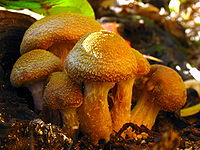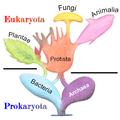The Fungi Portal
A fungus is any member of a large group of eukaryotic organisms that includes microorganisms such as yeasts and molds, as well as the more familiar mushrooms. The Fungi are classified as a kingdom that is separate from plants and animals. The discipline of biology devoted to the study of fungi is known as mycology or fungal biology, which is historically regarded as a branch of botany, even though genetic studies have shown that fungi are more closely related to animals than to plants. Fungi reproduce via spores and grow as hyphae, mycelia, and further specialized structures. Fungal spores are often produced on specialized structures or in fruiting bodies, such as the head of a mushroom. Abundant worldwide, most fungi are mostly invisible to the naked eye because of the small size of their structures, and their cryptic lifestyles in soil, on dead matter, and as symbionts of plants, animals, or other fungi. Fungi perform an essential role in the decomposition of organic matter and have fundamental roles in nutrient cycling and exchange. They have long been used as a direct source of food, such as mushrooms and truffles, as a leavening agent for bread, and in fermentation of various food products, such as wine, beer, and soy sauce.
Since the 1940s, fungi have been used for the production of antibiotics, and, more recently, various enzymes produced by fungi are used industrially and in detergents. Fungi are also used as biological agents to control weeds and pests. Many species produce bioactive compounds called mycotoxins, such as alkaloids and polyketides, that are toxic to animals including humans. The fruiting structures of a few species are consumed recreationally or in traditional ceremonies as a source of psychotropic compounds. Fungi can break down manufactured materials and buildings, and become significant pathogens of humans and other animals. Losses of crops due to fungal diseases or food spoilage can have a large impact on human food supplies and local economies. Despite their importance on human affairs, little is known of the true biodiversity of Kingdom Fungi, which has been estimated at around 1.5 million species, with about 5% of these having been formally classified.
| More about fungi... |
Selected article
Armillaria gallica is a largely subterranean fungus, and it produces fruit bodies that are up to about 10 cm (3.9 in) in diameter, yellow-brown, and covered with small scales. On the underside of the caps are gills that are white to creamy or pale orange. The stem may be up to 10 cm (3.9 in) long, with a white cobwebby ring that divides the color of the stem into pale orange to brown above, and lighter-colored below. The fungus can develop an extensive system of underground root-like structures, called rhizomorphs, that help it to efficiently decompose dead wood in temperate broadleaf and mixed forests. It has been the subject of considerable scientific research due to its importance as a plant pathogen, its ability to bioluminesce, its unusual life cycle, and its ability to form large and long-lived colonies.
Selected species
Things to do
If you want to help Wikipedia to improve its coverage of fungi, here are some things you can do...
- Assess some fungi articles.
- Join Wikipedia:WikiProject Fungi or ask on the talk page.
- Join the lichen task force.
- Review, improve, expand or clean some of the newly created fungi-related articles.
- Expand some high priority fungus stubs.
- Expand or sort other fungi-related stubs.
- Add images to articles in the list of unillustrated fungi articles, or add more articles to the list.
- Write fungi-related articles from scratch. For ideas of needed articles, see the redlinks on-
- Review the fungi articles flagged as needing attention.
WikiProjects
WikiProjects related to fungi:
Selected picture

Did you know?
- ... that the edible fungus Polyozellus multiplex has attracted research interest as a possible chemopreventative agent against stomach cancer?
- ... that the fungal genus Hericium includes the monkey's head fungus, used in Traditional Chinese medicine?
- ... that the rust fungus Puccinia jaceae var. solstitialis is the first plant pathogen approved by the United States Department of Agriculture as a biological control agent?
- ... that the Eyelash Cup normally grows on rotten wood, but can sometimes be found on bracket fungi?
- ... that the false earthstar in the fungal family Astraeaceae can open and close its rays in response to changes in humidity?
General images -
Related portals
Topics
- Main topics lists: Outline of fungi and Outline of lichens
- Fungi: Bracket fungus, carnivorous fungus, coprophilous fungi, entomopathogenic fungus, evolution of fungi, lichen, mushroom, mycology (lichenology, mycotoxicology, paleomycology), mycorrhiza, pathogenic fungi, puffball, wood-decay fungus
- Fungal orders: Chytridiomycota, Blastocladiomycota, Neocallimastigomycota, Zygomycota, Glomeromycota. Dikarya: Ascomycota, Basidiomycota
- Fungi lists: Species: Agaricus species, Amanita species, Boletus species, Cortinarius species, Cyathus species, Hygrocybe species, Hygrophorus species, Inocybe species, Lactarius species, Mycosphaerella species, Panaeolus species, Psilocybe species, Russula species, Scleroderma species Other lists: Mycology journals, psilocybin mushrooms
- Uses: Edible mushroom, mushroom poisoning, psilocybin mushrooms, mushroom hunting, fungiculture, fermentation, baker's yeast, mycoremediation, lichenometry, mushroom dye






















![Image 19Pennate diatom from an Arctic meltpond, infected with two chytrid-like [zoo-]sporangium fungal pathogens (in false-colour red). Scale bar = 10 μm. (from Marine fungi)](http://upload.wikimedia.org/wikipedia/commons/thumb/b/b5/Pennate_diatom_infected_with_two_chytrid-like_fungal_pathogens.png/120px-Pennate_diatom_infected_with_two_chytrid-like_fungal_pathogens.png)









































